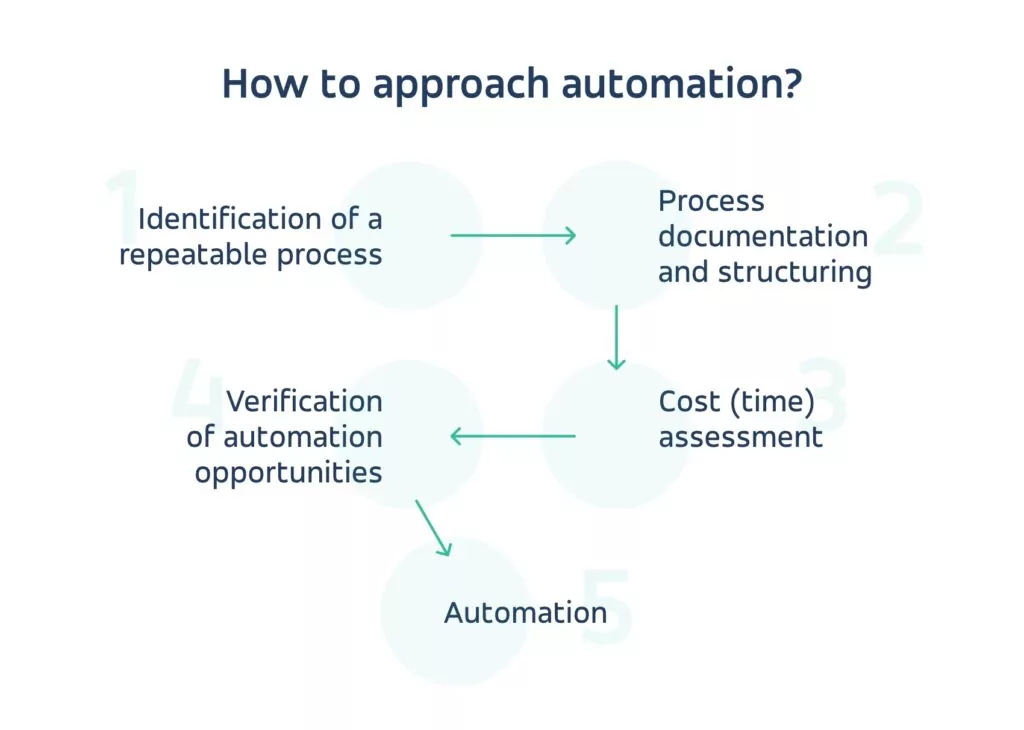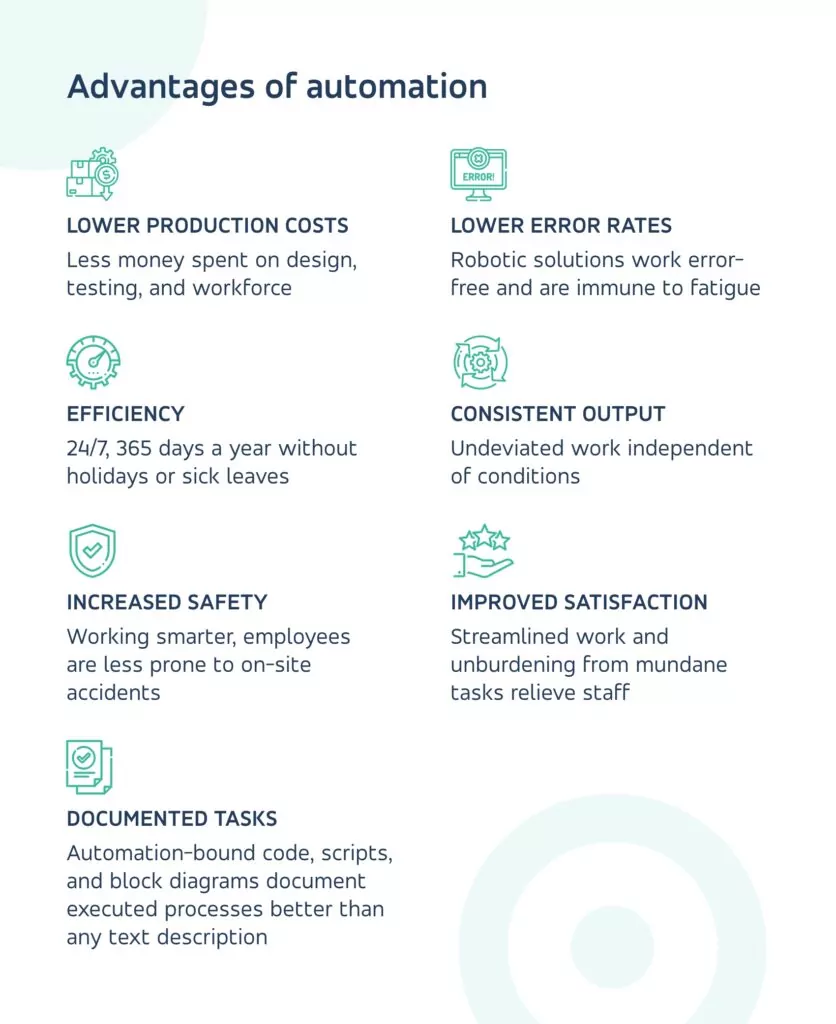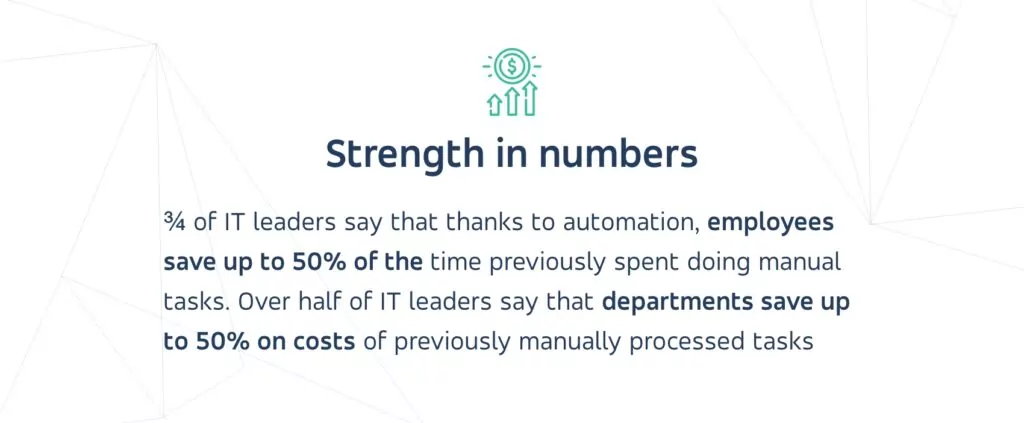Time is money. Digital solutions help companies save both.
What is automation?
A wide range of technologies used for work optimization is covered by the umbrella term. From IT automation and business process automation to personal applications, the shift in process execution is happening.
Automation is the process of achieving the state where human input is not necessary for task execution in line with expected results.

From documentation to automation
A vast amount of processes can be streamlined with documentation, allowing for the elimination of human errors and risk factors such as the time necessary for a new hire to acknowledge the process.

RPA (robotic process automation)
Robotic process automation orchestrates rule-based decision-making. In cases where the matrix behind each decision can be documented, listing values in rows and columns for identification, analysis, and performance rating, RPA can handle the execution. Assessing decision factors and their relative significance allows simple decisions based on provided data and criteria. When needed, the decisions too complicated from the robotic point of view proceed to people.
RPA is successfully implemented in various business fields, including e.g. sales, where software overlooks demand management and streamlines operations. Sales automation reduces the need for manual system updates, improves reporting, creation of proposals, resulting in improved business performance. RPA allows ceding tasks to “digital employees” who work error-free 24 hours a day with constant productivity, handling repetitive, mundane tasks well. Without ever requesting sick leaves or days off!
RPA solutions can be implemented as off-the-shelf automation software, depending on individual requirements and preferences. For instance, UiPath is an RPA tool for convenient automation of everyday duties. Thanks to its built-in solutions employees can be freed from repetitive tasks. Avoiding routine actions is possible thanks to a combination of predictive analytics, cognitive functions, and logic diagrams allowing automation of complex processes. The program facilitates convenient administration of rule-based tasks and enables sharing components between teams and projects, working as a well-oriented liaison.
IaC (infrastructure as code)
The approach allows companies to perform more efficient control changes and configurations in data centers, especially in cloud environments. IaC carries great potential in DevOps, enabling software developers to work closer to operational teams deploying virtual machines, the networks they support, and applications running on them.
The adoption of IaC depends on the decision between using imperative or declarative automation while making changes in the environment. The imperative approach is focused on how actions are performed, while declarative (known also as the model-based approach) concentrates on what should be achieved, without stating how it needs to happen.
IaC is declarative-first. The declarative approach facilitates automation, substituting command lines and detailed configuration steps. Instead, a concise specification of expected results (e.g. a virtual machine with an attached domain) is sufficient for the automated creation. Using a controlled system for setting up and configuration of virtual machines and networks allows smoother and faster creation, testing, and deployment of applications. The IaC approach streamlines the software development process, making it easier to follow, safer, and more efficient.
Automation at NeuroSYS
Internally, we’re working on tailoring automation software to serve our processes. Our team is creating modules of a comprehensive onboarding solution, which will answer the needs of our HR & administration departments.
As one of the systems’ modules, we’ll set up a contract generation robot. Its job will be to generate documents based on data provided by new hires in a Google form, outputting PDFs and Docx files ready for signing. As soon as the selected candidate accepts the job offer, their personal details will be fed to the robot, which will take it from that point. The next steps, dispatching e-mails, forms, document generation, adding the new employee to the employment list, etc., will be executed automatically.
The expected result is an extensive tool addressing several needs and unburdening staff from repetitive tasks which can be ceded to proprietary software.

What industries can be automated? What tasks are most suitable for automatic execution?
While most market areas gain from automation, the following industries are leaders in reducing human input in repetitive tasks:
Manufacturing
Inevitably in times of Industry 4.0, manufacturing benefits from solutions aimed at automating production processes and systems. The probably most widely used automation is robotic assembly lines, performing work previously carried out by people standing along the conveyor belts. Improving mass production and achieving better results with technology is the way to adapt operations to modern manufacturing, securing market position and competitiveness.
Healthcare
Areas like lab research and drug manufacturing already owe automation thanks for performing processes in a way unknown before. Using systems for processing and analysis of images allows for precise identification and counting of microbial organisms, used in medical and pharmaceutical research. Automation in healthcare covers not only the research and development part, as it can support medical staff in daily activities, reducing paperwork and improving accuracy in e.g. patient discharge and follow-up where no human interaction is necessary.
Transportation and logistics
Autonomous vehicles conquering streets worldwide incorporate dedicated software, thanks to which moving is possible without human actions. The industry uses the newest solutions to create automated transportation systems, including cars, trucks, and railways to enhance global logistics. Apart from surface transportation, aviation benefits from automated solutions in reservation systems and flight monitoring.
Agriculture
Farming automation systems use beacons and vegetation sensors to gather real-time data, analyzed further on to maximally improve the efficiency of plant breeding. Dedicated automation solutions govern crucial parameters, orchestrating e.g. light intensity or even the most beneficial color for certain crops, allowing the best harvest where nothing is left to chance (or human error).
IT
Automation in software development covers various processes such as business intelligence, application releases, deployment in the CI/CD approach, and testing. With tools like fastlane, developers can save hours of development time, automating every aspect of software creation, including building test versions, deployment, and scaling. Benefits include greater control over the process and its builds, improved development of new functionalities, more efficient quality control, and faster time-to-market.
Marketing
Marketing automation opportunities cover but are not limited to, improving the efficiency of email marketing, posting on social media, and planning (and executing) campaigns. Marketers utilize automation software to nurture customer relations, gain new leads, and improve sales, while preserving human resources to perform more demanding tasks, requiring more than just ticking the boxes.
Retail / ecommerce
Using crm automation software, retailers can change the way customers shop, handing more control over the process to consumers. Companies automate several processes, reducing human involvement in warehousing, manual data entry, collecting and dispatching orders. From adding pictures to individual listings to posting online offers with nearly 100% accuracy, dedicated software frees human resources to perform more specialized tasks. The tech potential lies mostly in the personalization of the experience and improved convenience, reflecting the progress this field has achieved since traditional brick-and-mortar purchasing.
Administration & HR
The most common administrative tasks are a grateful object for automation, as they are often simple and rule-based. Dedicated office software (like UiPath) takes care of e.g. email dispatch, auto-responding, filling out online forms, archiving documents, issuing invoices, filling databases, scheduling tasks & meetings. Similar benefits are widely available in HR, where repetitive actions related to candidate selection, hiring, and onboarding can be improved with automation. Once the employee is hired and trained, automation software can help take care of their scheduling and time tracking, improving operations in industries heavily reliant on efficient staff planning, like hospitality.
Training automation
Solutions like tailor-made learning management systems allow automated execution of employee training. The feature called Learning Tracks simplifies course assignment by admins, protecting users from being overwhelmed by the vast amounts of courses to complete. Learning Tracks enable automatic assigning of courses to new hires during onboarding, to employees according to date (e.g. when new regulations come into force), or any other key previously entered into the system: particular departments, employees holding certain job titles, etc., later on lining up further training.
The increasingly growing adoption of industrial AR enables automation of hands-on training, cutting operational costs, allowing standardized knowledge transfer. Augmented reality brings new quality into skill-building processes, freeing trainees from traditional classroom learning to in-position, hands-free instructions in real-world conditions.
Home automation
The growing popularity of solutions aimed at controlling home utilities, features, and appliances allows for improving the security and convenience of modern households. Home automation platforms govern smart home devices, facilitating management of domestic equipment, monitoring their status, preventing accidental water leaks, fires, and other potentially dangerous occurrences.
Main benefits of automation
Generally speaking, automation helps to improve the Bus Factor. It’s a measurement of risk connected to not sharing information and capabilities among team members. The term itself, slightly gruesome when you think about it, describes the minimum number of employees involved, whose sudden disappearance from the project would withhold its execution. Disappearance sounds less dramatic, yet, the expression “hit by a bus” was coined to emphasize the gravity of the situation.
With automation, less time is necessary to onboard employees joining projects, at the same time hardening companies against risks from team members leaving (not at all being hit by a bus). In well-secured processes, projects won’t stall in case the knowledgeable personnel ceases to work.
While the above may sound a tad too specific, the below chart shows typical advantages of automation:


While process automation may, to some extent, reduce the demand for certain jobs (according to McKinsey’s report, up to 30% of workers may need to retrain in new skills or consider a career change as a consequence of changes in labor demand), it is already creating new positions.
Process automation – where to start?
Every company, every department, and every position entails repetitive tasks. Performed daily or weekly, recurring tasks consume employees’ time, often causing burnout and affecting the company’s performance. Adoption of industry-specific solutions helps tackle the challenges and drive operations towards new quality.
As a rule of thumb, we automate processes that are:
- repetitive
- documented
- time-consuming
- carrying high risks
- prone to automation
- viable for automation
Are you looking for a digital transformation partner to help you with process automation in your industry? Book your 1-hour free consultation, and see how your operations can be streamlined with technology.





